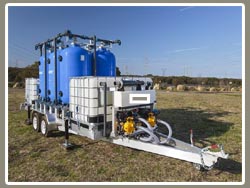


A mobile water treatment plant provides on-site, flexible purification solutions for emergency, remote, or temporary needs.
Portable systems that process water on site are transforming how communities and projects access clean water. By packaging treatment steps into a movable unit, these solutions bypass the limits of fixed infrastructure. They bridge gaps in supply, especially where building permanent plants is impractical.
Core Components
Every unit combines key elements to function independently. High-capacity pumps move raw water in and treated water out. Multi-stage filters—ranging from coarse screens to fine membranes—remove debris & microscopic particles. Holding tanks balance flow & provide contact time for treatment. Finally, a control panel coordinates pumps, valves and sensors to keep operations smooth. Need flexible water treatment? Visit the website now to explore our mobile water treatment plant solutions.
Treatment Processes
A typical system applies several methods in sequence. Sedimentation or flocculation settles heavy solids first. Activated carbon or ion-exchange media then capture chemicals and odors. Membrane techniques—such as ultrafiltration—block suspended particles and pathogens. Some setups include UV lamps or chemical dosing to inactivate bacteria and viruses before final distribution.
Deployment Strategies
Units arrive on trailers, trucks or skid mounts. Site selection factors in access, ground stability and proximity to water sources. Quick-connect hoses link to intake points and distribution lines. Electrical hook-ups may rely on generators or local grid connections. Clear setup protocols ensure rapid start-up and consistent output.
Operation and Monitoring
Operators follow standard startup & shutdown sequences to protect equipment. Inline sensors track flow rate, pressure differentials and water quality indicators like turbidity or pH. Data streams feed into simple dashboards or cloud platforms for remote oversight. Automated alerts flag deviations that could signal leaks, clogging or treatment lapses. Rent water treatment equipment – visit our website to find the perfect solution!
Maintenance and Troubleshooting
Routine tasks include backwashing filters, replacing media cartridges and calibrating sensors. Visual inspections catch seal wear or corrosion early. When issues arise—such as pump cavitation or membrane fouling—step-by-step guides help pinpoint and correct faults. Keeping spare parts on hand reduces downtime.
Use Cases and Advantages
These movable treatment units serve emergency response teams, construction sites and temporary camps. They cut delivery costs by treating water at the point of need and reduce losses in long pipelines. Scalability allows linking multiple units for higher capacity or pairing with storage reservoirs for peak-demand buffering.
Emerging Trends
Next-generation designs focus on lighter frames and plug-and-play modules. Advances in renewable energy—solar-powered pumps or gravity-driven flows—shrink footprints and cut operating costs. Smarter controls leverage machine learning to optimize chemical dosing and predict maintenance windows before breakdowns occur.
Author Resource:-
Lee Wood writes about sustainable and scalable water and wastewater treatment solutions.
